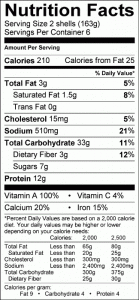Pumpkin Season
Fall is one of our favorite seasons. The air is cooler, the days feel shorter, and there’s pumpkin everywhere!
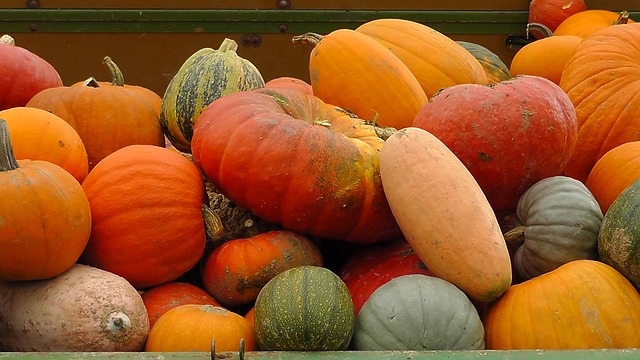
Pumpkins are loaded with Vitamin A, fiber, and low in calories. Whether fresh or canned pumpkin puree, it’s versatility makes it a great addition to any recipe. Below is one of our favorite recipes from our friends at foodhero.org. Check it out!
Pumpkin Ricotta Stuffed Shells
Ingredients:
Directions:
- Cook pasta shells according to package directions. Drain, separate onto baking sheet and let cool.
- In a medium bowl, stir together ricotta, pumpkin, Parmesan, and spices. Reserve 1 Tablespoon Parmesan for topping.
- Preheat oven to 350 degrees. Choose a baking dish that holds all the shells in a single layer.
- Spread pasta sauce in the bottom of the baking dish. Fill each shell with about 3 Tablespoons of pumpkin mixture, and place shells close together on sauce in baking dish.
- Cover pan with foil and bake for 30 minutes. Remove foil, sprinkle with remaining cheese and bake for 15 minutes more.
- Refrigerate leftovers within 2 hours.
Notes
Pizza? Spaghetti? Why not both?
I love recipes. No, I mean I REALLY LOVE recipes. I can often be found at night searching the internet, magazines, and my cookbooks for recipes to inspire me in my meal planning. While searching for recipes, I came across the “What’s Cooking? USDA Mixing Bowl” site that features several on-line cookbooks such as The White House Cookbook, The Healthy Lunchtime Challenge Cookbook, Healthy Eating on a Budget Cookbook and MyPlate Cookbook by Goya which focuses on Healthy Tasty Affordable Latin Cooking. To check these out and find some recipes for your family, go to: http://www.choosemyplate.gov/recipes-cookbooks-and-menus
I find several recipes that are similar and pick out my favorite parts from each one to make my own recipe that I know my family will enjoy. Today’s recipe is a mash-up of two kid favorites – Pizza and Spaghetti. You can’t go wrong with those two! I hope you will enjoy making and eating this casserole to which you can add your own favorite pizza toppings.
Pizza Spaghetti Casserole
Ingredients:
- 1 lb. ground meat (beef, turkey or chicken)
- 1 16 oz. box uncooked whole wheat spaghetti noodles (other noodles wil
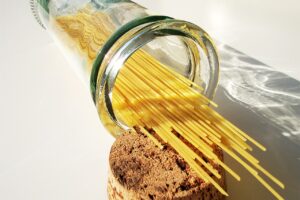 l also work)
l also work) - ½ teaspoon oregano
- ½ teaspoon garlic powder
- ½ cup milk
- 1 egg
- 2 ounces sliced pepperoni (try Turkey pepperoni)
- 1 (26 ounce) jar pasta sauce
- 1 16 oz. can diced Italian style tomatoes
- ¼ cup grated parmesan cheese
- 1 (8 ounce) package shredded Italian cheese blend
- Any other pizza toppings like Black olives, sausage, onions, green peppers, etc…
Directions:
- Cook spaghetti according to package directions.
- Brown meat in a separate frying pan.
- Once noodles are cooked, drain and put in a casserole dish sprayed with non-stick cooking spray.
- In a separate bowl, whisk together the milk and egg.
- Pour over pasta and add jar of sauce, can of tomatoes, garlic powder, & oregano. Mix all together well.
- On top of pasta mixture, spread ground meat and any other additional toppings you may like then add a layer of pepperoni.
- Sprinkle the Parmesan cheese, & Italian cheese over top and finish with another layer of pepperoni.
- Bake in the oven at 350˚F for 30 minutes.
Source: Suzanne’s personal recipe
Suzanne
Coffee and Health
Did you know, a plain cup of brewed coffee has only 2 calories and no fat. However, if you like to add flavored creams, sugars, etc., the calories quickly add up. See how many calories just 1 tablespoon of these extras can add to your coffee:
• Heavy whipping cream: 52 calories
• Table sugar: 49 calories
• Half-and-half: 20 calories
• Fat-free milk: 5 calories
When purchasing coffee at a local shop, be sure to check out the nutrition information before you order. Some coffee drinks are more like dessert and can have hundreds of calories. Occasional indulgence is fine. But remember all calories count — even calories in liquid form.

Recent studies have found no connection between coffee and an increased risk of cancer or heart disease. Studies have also shown that coffee may have health benefits, including protecting against Parkinson’s disease, type 2 diabetes and liver disease, including liver cancer. It also appears to improve cognitive function and decrease the risk of depression.
However, the research appears to bear out some risks. High consumption of unfiltered coffee (boiled or espresso) has been associated with mild elevations in cholesterol levels. And some studies found that two or more cups of coffee a day can increase the risk of heart disease in people with a specific, and fairly common — genetic mutation that slows the breakdown of caffeine in the body. So, how quickly you metabolize coffee may affect your health risk.
Although coffee may have fewer risks compared with benefits, keep in mind that other beverages, such as milk and some 100% fruit juices contain nutrients that coffee does not.
Source: Mayo Clinic
-Stephanie
Better Breakfast Day
September 26th is Better Breakfast Day! What’s that all about?
The answer to that question can be found in the results of research conducted on the benefits of eating breakfast. Studies based on the behaviors of all Americans – children, adolescents and adults – have shown these benefits can be categorized into three general areas: Nutrition, Health, and Performance. Let’s look at each of the areas separately starting first with “Nutrition”.
According to the Dietary Guidelines, we need a new supply of nutrients each day to keep our organs functioning and our bodies healthy. It would be difficult to get all the nutrients we need (like the required amounts of vitamins, minerals and fiber) if we skipped breakfast. Research has shown that eating breakfast not only gives us a jump-start in meeting our nutrient requirements for the day, it also sets the stage for our making better food choices throughout the day. Now, just think about that a minute! Do you eat better throughout the day when you eat breakfast? Bet you do!

In the area of “Health”, research has shown that eating breakfast can help control one’s weight. How is that possible? Well, as we mentioned before, people who eat breakfast are more likely to make better food choices during the day. For example, unlike breakfast skippers who often scarf down high calorie junk food when they get hungry mid-morning or at lunch, breakfast eaters aren’t as hungry and tend to choose more thoughtfully, taking into consideration the sugar, fat and calorie content of the food they choose to eat. Plus, breakfast eaters are typically more physically active than non-breakfast eaters. The marrying of these three behaviors – eating breakfast, making wise food choices during the day, and being physically active – are contributing factors to not only managing one’s weight, but to also controlling the onset of other health issues like heart disease, diabetes and metabolic syndrome. It’s amazing that simply eating breakfast can have such long-range health benefits, isn’t it?
Lastly, eating breakfast provides benefits in the area of “Performance”. Researchers agree that breakfast consumption has a positive impact on cognitive and academic performance. For example, children who eat breakfast do better on standardized tests, are late or absent less often, and have less trouble concentrating than their breakfast skipping counterparts. As for adults, research has shown that skipping breakfast can also interfere with their ability to think and learn. Even a simple breakfast of corn flakes and milk can provide a new supply of glucose, that will in turn, heighten their creativity and make them more productive during the day.
Although breakfast is often pushed to the bottom of our priority list, it’s pretty easy to see why it truly is the most important meal of the day. For nutritional, health, and performance ability reasons, we all should eat a healthy breakfast every day.
So, don’t delay! To learn more, read “Now Serving Breakfast” and “The Importance of Eating a Healthy Breakfast” and start planning a Better Breakfast Day at your house tomorrow… and every day of the year!
Virginia
Pregnancy and Food Safety
As parents we all want the very best for our children. I remember when I learned that I was pregnant. I listened to all the advice from my doctor, my mother, my friends, and people who just randomly offered it. And, sometimes there would even be a segment on the news or a talk show about what you should or should not do during pregnancy. Sometimes one person would tell me one thing and then someone else would say the opposite. It was all very confusing and I wanted to be sure to listen to the right advice because I knew everything I did affected my baby, especially my food choices.
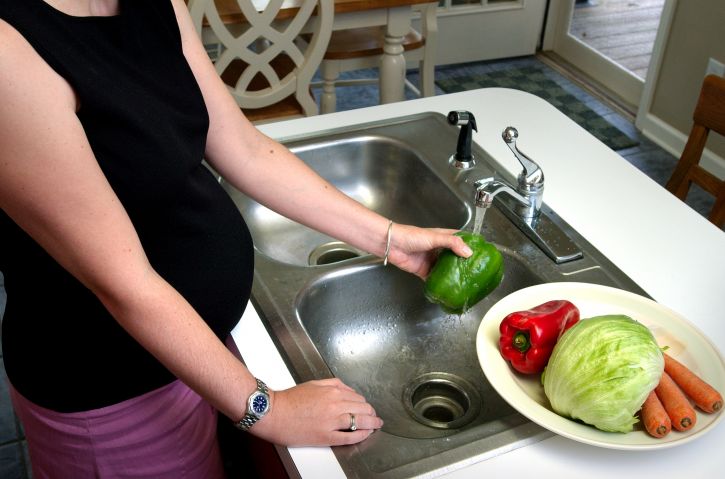
Finding a reliable source of information became very important. The news would often talk about the dangers of certain foods during pregnancy, but the reports always seem to focus on one particular food that had been reported to cause problems. There was no list of specific foods to avoid and no reference to a good source for that information. I began to look for reliable information. Both WIC and Cooperative Extension were very helpful in pointing me to resources that gave me reliable information. There is a really good resource that I want to share with you. You can find it at: http://www.foodsafety.gov/risk/pregnant/
The general guidelines for foods to avoid are listed in a brief overview, but you can also get specifics when you click on the links for each food. For instance, a general guideline is to choose seafood carefully. When you click on the link, it has a list of the specific types of fish that can be a problem. Additionally, this site has an infographic that summarizes the recommendations (see below). If you have access to a printer at home or at a school or library, you can print this out and place it on your refrigerator as an easy reminder.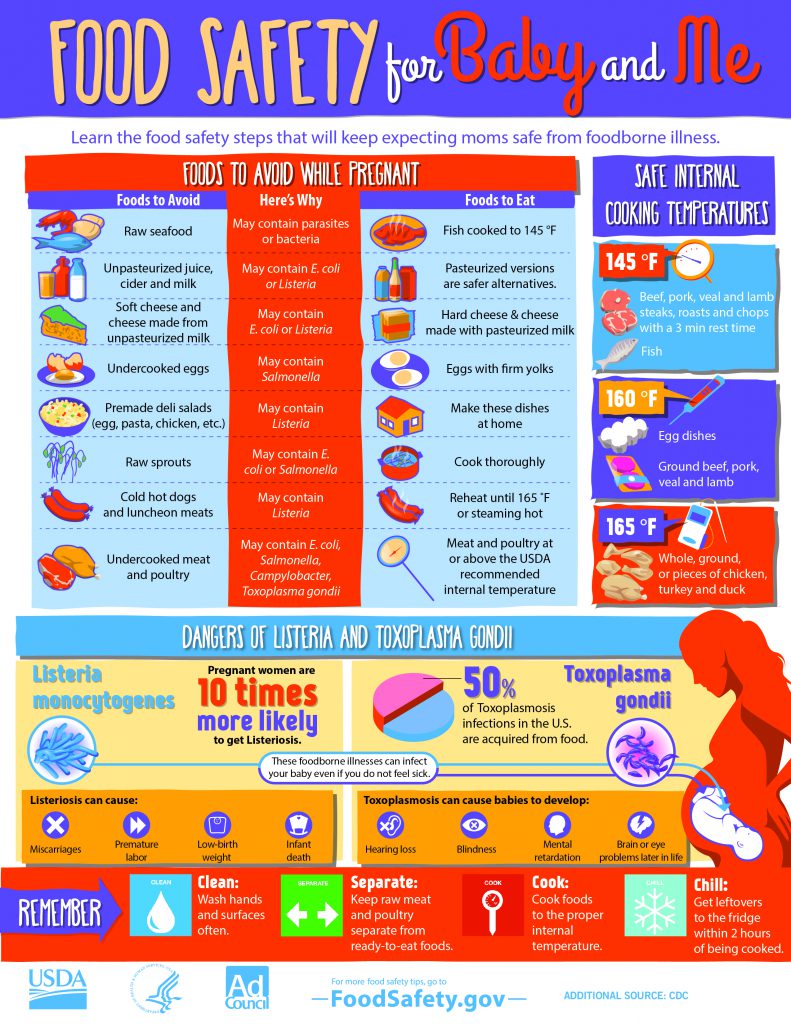 -Lorelei
-Lorelei
